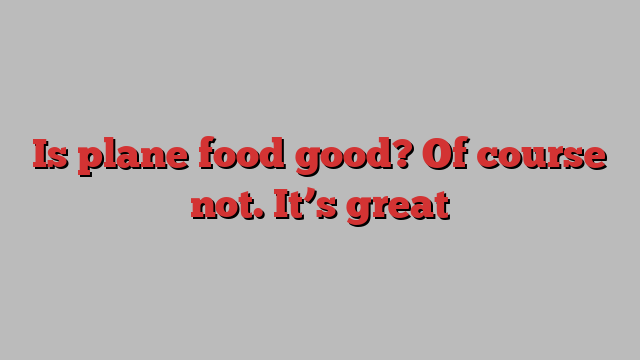
Unlock the Editor’s Digest for free
Roula Khalaf, Editor of the FT, selects her favourite stories in this weekly newsletter.
It was probably one of the worst meals I’d eaten since the nuns used to monitor our every mouthful during school dinners. There was meat of a colour that should never appear in nature, lurking — inexplicably — in pickle juice. A salad to start, five defeated leaves (I counted them), one anaemic cherry tomato, halved, a tiny phial of solidified dressing. Bread as appetising as a foam scrubber. Did I turn up my offended nose? Nope, I ate the lot. I was on a plane.
Once through departures at the airport, my standards plummet. Pret starts looking like the ultimate destination in these weird nowhere spaces. But even this lack of discernment seems picky once I get on to the plane.
At ground level, I’m an unabashed food snob. No apologies: why not be selective about what you pay for with your precious money and put into your precious body? But all that changes as soon as the seatbelt sign goes on. Instead of caring whether my meat is organic or my balsamic the real, Modenese deal, I’ll hoover anything that comes off the trolley: bendy croissants on Ryanair or easyJet’s notorious cheese and ham “toasties” — damp loofahs the temperature of molten lava. There are those who come prepared: well-travelled pals with their own soda bread, smoked salmon, lemon and capers, or the fixings for crisp sarnies. (That saltiness is no coincidence: taste is deadened in the air. Which is perhaps why, when I still used to drink on flights, I always fell into the umami bomb of Bloody Marys.)
There’s no way I’m bringing my own food. First, I know that the young-me-on-a-school-trip will resurface and I’ll polish off my packed lunch before take-off. And secondly, there’s a deliberate pace to the doling out of meals and snacks, especially on long-haul, one designed to keep people docile, scores of them, rammed together with the seat-kicking toddlers and charmers who recline seats for the duration.
So I put myself in the hands of the catering companies, in full anticipation that whatever arrives will be fair to dismal, even in upper classes. Ingredients do not respond well to the processes needed for airborne food and, due to cabins’ lower levels of humidity than most deserts, taste and smell are impacted so negatively that dishes have salt and sugar cranked up to 11 while still managing to taste and smell like stew. But I’ll still await the trundle of the trolley feverishly, proper Stockholm syndrome stuff.
I’ve been lucky enough to have had various first-class flights over the years. BA, where there’s a strange penumbral bar that seems never to close, a shiny, modular version of the one in The Shining, furnished with polystyrene muffins and palate-lacerating crisps. Emirates, where there was filet mignon, lobster and white burgundy, and the pal got so blootered he couldn’t find his way out of the cabin’s spa — yes, spa — and thought he was going to perish when we arrived at a stopover in Dubai. (This was not the experience that led me to no longer drink on flights. That story involves a flight to Vegas.)
Top larks, but the filet mignon was an unyielding taupe dollop, the lobster cosplaying as crabsticks. Dump caviar on top of all this and you’re still lipsticking the pig. You’d think an airline serving a reported 77 million meals a year might have got it down to the finest art, but it wouldn’t have mattered anyway. I thrilled to every moment.
There have been odd joys, sure: a surprisingly edible sorta-calzone on one of the budget carriers; cheese and biscuits, even if they haven’t heard of a cracker post-Jacob’s; microwaved curry, though you risk fellow-traveller unpopularity. All of this, of course, is based on very personal experience; I haven’t experienced the sort of “haute cuisine” offering that major airlines do in collaboration with starry chefs: Qantas’s Neil Perry, or Japan Airlines’ Ishikawa Hideki, or Carlo Cracco, randomly, for Singapore Airlines. Air France has a dazzling firmament, including Anne-Sophie Pic, the world’s most-awarded female chef.
But even with boldface names attached, I’m sceptical, pretty confident the bread will be bendy, the pasta knackered (it’s frequently prepared about 12 hours before flight) and, despite lip service towards trends for healthier eating, the vegetables one step away from soup.
I don’t know why they bother, given that most of us will eat and enjoy anything while airborne. Bring it all on: the dusty chocolates, stiff little sandwiches, rubbery eggs and bacon that looks as if it has a fungal infection. Will it be “good”? Don’t make me laugh — my mouth is full.
Marina O’Loughlin is a writer, editor and restaurant critic. This is the second of four summer columns
Follow @FTMag to find out about our latest stories first and subscribe to our podcast Life and Art wherever you listen